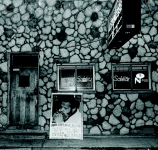|
|
 |
Dusted Reviews
Artist: V/A Album: Light: On the South Side Label: The Numero Group Review date: Nov. 2, 2009 |

|
|
|
 |
Two blocks south and as many east of 2120 S. Michigan Avenue, Pepper’s was one of a handful of clubs where the Chicago blues hid out in the 1970s before heading north to whiter pastures. “Every Night Like New Year Eve” was the promise printed on the proprietor’s business cards, and from the sights and sounds of Light: On The South Side – the Numero Group’s two-LP and 132-page art book memorializing the scene – the slogan was an apt one. Both the music and the photographs are expressive of that long kiss at midnight – blues locking lips with funk, fur trim crushing up against double-knit polyester.
The double LP portion of Light: On The South Side takes the same approach as the Numero Group’s Eccentric Soul series: the tracks compiled were originally released as 45s by upstart local labels whose stocks have vanished for all but the hungriest scavengers. Two of the imprints featured here were housed on the second floor of Pepper’s and run by club co-owner Mack Simmons, who had a hand in much of this material. When he wasn’t releasing singles, or using Pepper’s as a front to sell heroin, Simmons was working hard to live up to his boast as “the world’s greatest harmonica player.” His harp floats over the rubbery bass lines of many of the best of these cuts.
What makes Light: On The South Side more lavish than any entry in Eccentric Soul (and if you know Numero, you know that’s saying something) is the accompanying book of photographs. Housed today in major museum collections, these images are the result of an obsession by Michael L. Abramson, then a skinny white 23-year-old living in Evanston. In a brief essay in the back of the book, Abramson writes of his persistence and the acceptance he gained as an outsider, but the claim is redundant; the images demonstrate it. Many of Abramson’s black-and-white snaps are candid – the half-closed lids and ecstatically rolled eyes of couples dancing cheek-to-cheek, bar money squeezed into the palms of patrons waylaid on the dance floor – but just as many document seized opportunities to pose. At Pepper’s, where Abramson describes the scene as “menthol, bourbon, and the blues,” such subjects include middle-aged sisters in feathered caps, flashing identically gapped smiles. At Perv’s house – where it was “Donna Summer and gold lamé” – it means burlesque dancers in pasties and young men in cocked fedoras, posing with boxes of Pimp Oil (one of Simmons’ countless side ventures).
In the past, this publication has come down hard on certain Numero Group releases, arguing that the effusive presentation has stood in contrast to the quality of the music. For a number of reasons that critique doesn’t fly here. These are terrific cuts, with solid production values, charismatic singing (Arlean Brown sets the tone early: “I got hips like two-gun Pete when he’s on duty / Chest like headlights on a pimp’s car, diamonds in the back you know that’s a beauty”), and soulful playing. Just as importantly, they’re winning in a particular way – an ideal soundtrack to a slow tour of the photos. Abramson’s images help to repurpose Pepper’s Jukebox, the two-LP compilation. Instead of purported treasure for skeptics to reject using their Chess-issued rubrics, this music serves as a vehicle, transporting the listener to a boozy Tuesday night in a time and place it’s fun to fantasize about. These are studio-recorded, commercially released singles, but it’s easy to imagine them being belted from the stage in Pepper’s Persimmon Room. None of the arrangements are by Charles Stepney and none of the singers are Etta James, but neither do they claim to be. So much of this is brawny, stripped-down, and swaggering. Horn sections, cooing backing vocalists, and psychedelic fuzz crop up now and again, but the common bedrock is rolling bass, skipping snare, slinking electric leads, and screeching harp – a few degrees funkier, but still the Chicago blues.
Workmanlike is too much of a pejorative, but that’s the quality that makes this set special, however paradoxical that sounds. At Pepper’s it was “Every Night Like New Year Eve” – not just select Saturdays. “I shot five or six nights a week,” Abramson writes in his essay; Bobby Rush (“Sitting in a car and the car won’t go / That’s the way you spell Chicago”) and Willie Davis (“Every day and every night when I come home / I wake up my darling and fight”) sound like they delivered (and lived) these songs just as often. Flipping pages and LP-sides, it’s that tension between “Every Night” and “New Year Eve” that resonates: one woman sits alone at a table full of empty glasses and a crushed pack of Salem’s, maybe thinking about work in the morning. Another is decked out in pounds of jewelry, an hour’s worth of makeup, and nothing to hide her midriff, looking like tomorrow is the last thing on her mind. The doors would close at two, and then for good, but this set throws them joyfully back open. As second chances go, this one’s pretty irresistible.
By Nathan Hogan
|







